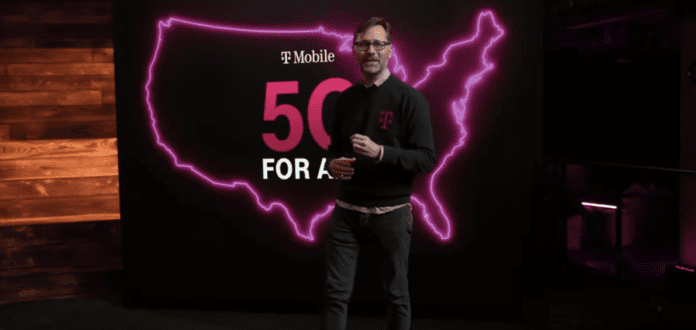Latest T-Mobile US “Un-carrier” event featured strong focus on 5G for rural America
In terms of 5G creating long-term user value and service provider revenue, the high-level global focus is on enterprise enablement. 5G for consumers is an expected evolution–higher speeds, lower latency, faster downloads and so forth, but not necessarily as economically impactful as facilitating industrial automation or enabling autonomous guided vehicles. T-Mobile US last week hosted an “Un-carrier” event focused on driving consumer 5G uptake by undercutting competitor pricing, offering free handsets, and complementing mobile service with home broadband service; the theme of “5G for all” was front and center with executives talking up the benefits 5G can bring to rural Americans with EVP of Consumer Markets Jon Freier describing T-Mo’s goal as becoming the “hometown network” of smaller towns and cities across the country.
All that to say, there’s fairly broad consensus that T-Mobile currently has the edge on network in the U.S. as compared to AT&T and Verizon. T-Mobile has a nationwide standalone 5G network using its 600 MHz network, has rapidly deployed the 2.5 GHz spectrum holdings it picked up with the Sprint merger, and has selectively deployed millimeter wave while regularly roasting Verizon for its focus on high-band 5G spectrum. But despite having the network advantage, T-Mobile’s 5G monetization strategy, based on this latest slate of announcements, seems hinged on capturing subs churning off of competitors’ networks as a function of price and perks. While T-Mobile has expressed its intention to grow its enterprise foothold, AT&T and Verizon have painted a more specific, long-term narrative around new service revenues coming from business customers using 5G and mobile edge computing to solve particular business problems.
Light Reading‘s Mike Dano sparked an interesting Twitter conversation with an initial characterization of T-Mo’s move as the “5G ‘nuclear option,'” then amending that description to “like putting in the final puzzle piece.” Two responses stood out to me and to be clear, these aren’t people I know or can in any way gauge the credibility of, but the comments are relevant to this narrative. First, an analyst with the handle @bryson said, “This should confirm whether or not telecoms can successfully sell mobile 5G still lacking a real consumer use case.” Next, a user called Geoff wrote, “We’re going to make the switch. Not because of 5G or performance, but because Verizon has priced themselves out with their abysmal ‘unlimited’ plans.”
That kind of encapsulates the whole thing: 5G as a consumer technology doesn’t necessarily command a premium because there’s no break out use case that only 5G can support. It’s the same applications associated with LTE just done faster. As such, the revenue opportunity is in growing the subscriber base and putting them on a network that transmit bits per hertz more cost-efficiently than LTE.
5G fixed wireless access
T-Mobile has long planned to enter the home internet space, couching its approach as disrupting monopolistic market capture from incumbent cable companies. For some time T-Mo has been running an LTE-based fixed wireless pilot project, progressively scaling up the availability of the program.
Now the 5G-based version of this service is up and running with approximately 30 million homes initially covered; a full list of cities is available in this PDF. Company CEO Mike Sievert said T-Mobile is now effectively one of the largest ISPs in the country by service area. The home internet service is available based on network capacity so there may be some geographic limitations to the total number of potential subscribers. It costs $60 per month and will deliver speeds in the neighborhood of 100 Mbps.
“We can launch big because we’ve built the network and we’ve been piloting home internet for over a year to really nail the customer experience,” Sievert said in an online event. “Millions of American families can save $100s of dollars each year with T-Mobile…you can cut the cord with the cableopoloy for good.” He noted that roughly one-third of the 30 million eligible homes are in rural and small towns. “From the beginning, one of our most important goals has been to ensure small town America isn’t left behind in this generation of wireless,” Sievert said.
In his latest installment of The Sunday Brief, analyst Jim Patterson breaks down T-Mo’s home internet plan and sees the new service as offering attractive pricing relative to cable companies. The question then becomes if home internet user demand “is far greater than expected, will they ration or limit the number of customers the service is available to after they have hit their fill rate?”
T-Mobile as “Your hometown network”
T-Mobile offers nationwide 5G service using its low-band spectrum if a standalone mode of operation. In the company’s layer cake analogy, the 600 MHz forms the foundation. Given its network reach and historic underperformance in rural and smaller markets, T-Mobile is now positioning itself as “your hometown network,” according to comments from Freier during a webcast last week.
In a video spot filmed in Manhattan, Kansas, population approximately 55,000, Frier said rural Americans face economic challenges that can be lightened by access to quality, affordable telecommunications services. But, “It will take more than just better infrastructure,” he said. “It will take a long term commitment to the people and local businesses that are the real heart and soul of small town America.”
To that commitment point, Freier said T-Mobile will create 7,500 new jobs in rural communications over the next two years. Those jobs will be in new retail stores opening in smaller towns and also via a new program called “Hometown Experts;” that program involves individuals serving as one-stop company reps in areas where there aren’t brick and mortar retail locations.

